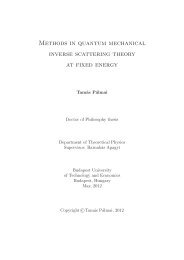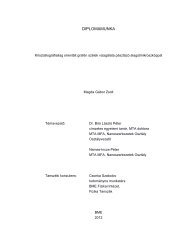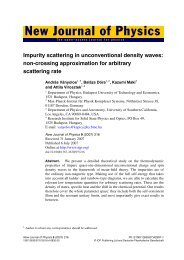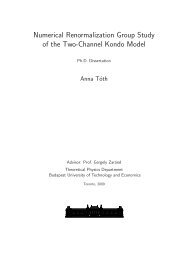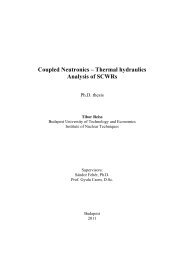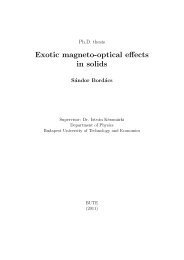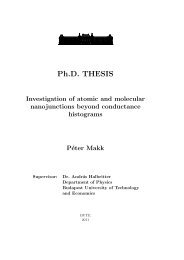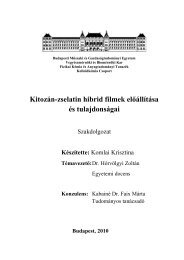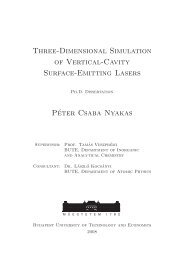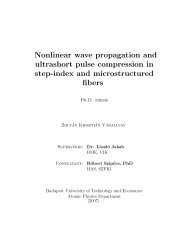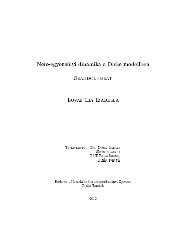Ph.D. THESIS Multipolar ordering in f-electron systems
Ph.D. THESIS Multipolar ordering in f-electron systems
Ph.D. THESIS Multipolar ordering in f-electron systems
You also want an ePaper? Increase the reach of your titles
YUMPU automatically turns print PDFs into web optimized ePapers that Google loves.
Chapter 1<br />
Introduction<br />
Orbital <strong>order<strong>in</strong>g</strong> phenomena <strong>in</strong> f-<strong>electron</strong> <strong>systems</strong> have been extensively<br />
studied <strong>in</strong> the past two decades. The highly degenerate f-shells of rare<br />
earth and act<strong>in</strong>ide ions support a great variety of local degrees of freedom:<br />
magnetic, quadrupolar and octupolar at least. This leads to variegated and<br />
complex phase diagrams and magnetic properties. Quadrupolar <strong>order<strong>in</strong>g</strong> was<br />
found to expla<strong>in</strong> the properties of many Ce, Tm and Pr-based rare earth compounds<br />
like CeB 6 , TmTe, and PrPb 3 . The detailed theory of CeB 6 conta<strong>in</strong>s<br />
the first full symmetry classification of multipoles, <strong>in</strong>clud<strong>in</strong>g the effect of an<br />
external magnetic field [5].<br />
In earlier studies, orbital <strong>order<strong>in</strong>g</strong> was usually understood to mean just<br />
quadrupolar <strong>order<strong>in</strong>g</strong>, but it has become clear that <strong>order<strong>in</strong>g</strong>s of higher multipoles<br />
are also realized <strong>in</strong> some f-<strong>electron</strong> compounds. Recent experimental<br />
observations on NpO 2 <strong>in</strong>dicate that the primary order parameter of the 25K<br />
phase transition is purely octupole. Multipoles of still higher order, namely<br />
hexadecapoles and triakontadipoles may play a role <strong>in</strong> the physics of Pr-filled<br />
skutterudites and URu 2 Si 2 . The physics of multipolar <strong>order<strong>in</strong>g</strong>s is far from<br />
be<strong>in</strong>g fully explored yet.<br />
One may th<strong>in</strong>k that higher order multipoles are irrelevant because their<br />
<strong>in</strong>teraction is much weaker than ord<strong>in</strong>ary dipolar <strong>in</strong>teraction. This seems to<br />
be suggested by the multipole expansion <strong>in</strong> classical electrodynamics. This is,<br />
however, mislead<strong>in</strong>g. The lead<strong>in</strong>g <strong>in</strong>teraction term between the multipoles<br />
has quantum mechanical orig<strong>in</strong>, it is mediated by <strong>electron</strong>s <strong>in</strong> wide bands<br />
like the usual <strong>in</strong>direct exchange <strong>in</strong>teraction, thus the <strong>in</strong>teractions between<br />
multipoles with different rank are equally important.<br />
Many f-<strong>electron</strong> <strong>systems</strong> order magnetically. However, quite a few f-<br />
<strong>electron</strong> <strong>systems</strong> have phase transitions which are thermodynamically as<br />
strong as the magnetic transitions, but the low temperature phase is not<br />
magnetically ordered. In these cases, we associate the phase transition with<br />
3



